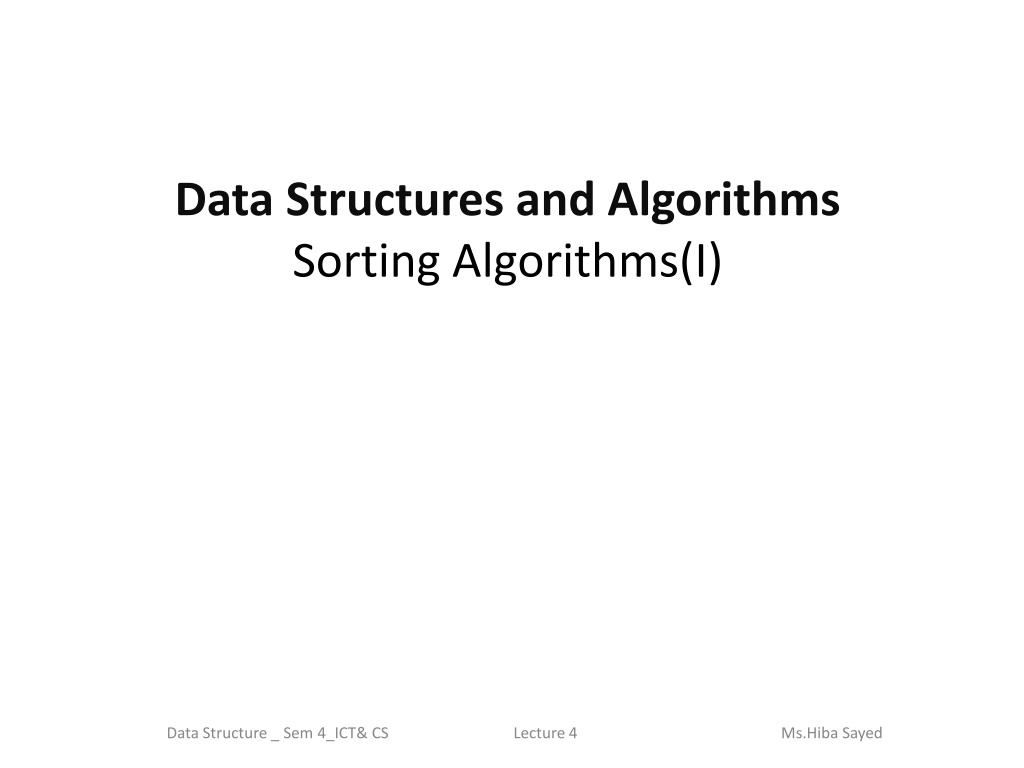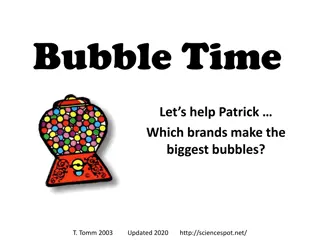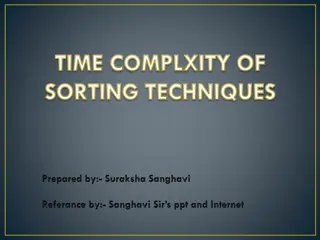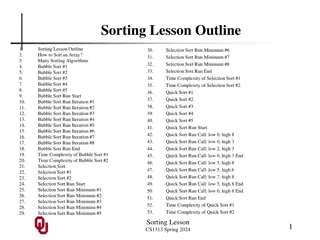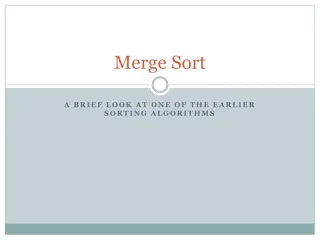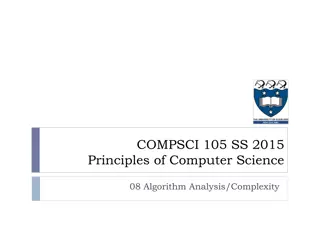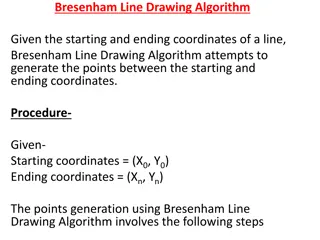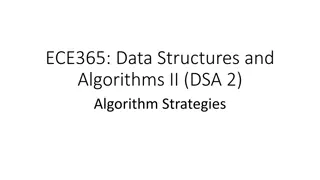Introduction to Bubble Sort Algorithm
Bubble sort is a simple comparison-based sorting algorithm that repeatedly compares adjacent elements and swaps them if they are in the wrong order. It is easy to implement but inefficient for large datasets. The algorithm iterates through the list multiple times until no more swaps are needed, ensuring the elements are arranged in the desired order. This summary provides an overview of the working principle of bubble sort using examples and visuals.
Download Presentation

Please find below an Image/Link to download the presentation.
The content on the website is provided AS IS for your information and personal use only. It may not be sold, licensed, or shared on other websites without obtaining consent from the author. Download presentation by click this link. If you encounter any issues during the download, it is possible that the publisher has removed the file from their server.
E N D
Presentation Transcript
Data Structures and Algorithms Sorting Algorithms(I) Data Structure _ Sem 4_ICT& CS Lecture 4 Ms.Hiba Sayed
Introduction to Sorting Algorithms Sort: arrange values into an order: Alphabetical Ascending numeric Descending numeric There are many different types of sorting algorithms, but the primary ones are: Bubble Sort Selection Sort Insertion Sort Merge Sort Quick Sort Four algorithms considered here: Bubble sort Selection sort Insertion sort Quick Sort
Bubble Sort Bubble sort is a simple sorting algorithm,orders a list of values by repetitively comparing neighboring elements and swapping their positions if necessary Concept: Compare 1st two elements If out of order, exchange them to put in order Move down one element, compare 2nd and 3rd elements, exchange if necessary. Continue until end of array. Pass through array again, exchanging as necessary Repeat until pass made with no exchanges
Example First Pass Array numlist3 contains: 17 23 5 11 compare values 17 and 23 in correct order, so no exchange compare values 23 and 11 not in correct order, so exchange them compare values 23 and 5 not in correct order, so exchange them
Example Second Pass After first pass, array numlist3 contains: 17 5 11 23 compare values 17 and 5 not in correct order, so exchange them compare values 17 and 23 in correct order, so no exchange compare values 17 and 11 not in correct order, so exchange them
Example Third Pass After second pass, array numlist3 contains: 5 11 17 23 compare values 5 and 11 in correct order, so no exchange compare values 17 and 23 in correct order, so no exchange compare values 11 and 17 in correct order, so no exchange No exchanges, so array is in order
Algorithm Bubble Sort (numlist3,N element): for i := 1 to N-1 do { for j := 0 to N-i-1 do { if (numlist3 [j] > numlist3 [j+1] ) { temp := numlist3 [j]; numlist3 [j] := numlist3 [j+1]; numlist3 := temp ; } } }
A Bubble Sort Function Exercise:Rewrite using for loop ,while loop and using Temp() function Rewrite Bubble_Sort using for loop ,while loop and using Temp() function Bubble_Sort( ) function ( ) function
Bubble Sort - Tradeoffs Benefit: Easy to understand and implement Disadvantage: Inefficient: slow for large arrays
Selection Sort Selection sort is a good algorithm to sort small number of elements, orders a list of values by repetitively putting a particular value into its final position Concept for sort in ascending order: Find the smallest value in the array. Locate smallest element in array. Exchange it with element in position 0 Locate next smallest element in array. Exchange it with element in position 1. Continue until all elements are arranged in order
Selection sort example 2 Index 0 1 2 3 4 5 6 7 Value 27 63 1 72 64 58 14 9 1st pass 1 63 27 72 64 58 14 9 2nd pass 1 9 27 72 64 58 14 63 3rd pass 1 9 14 72 64 58 27 63 The selection sort marks the first element (27). It then goes through the remaining data to find the smallest number(1). It swaps this with the first element and the smallest element is now in its correct position. It then marks the second element (63) and looks through the remaining data for the next smallest number (9). These two numbers are then swapped. This process continues until n-1 passes have been made. 12
Selection Sort Example3 Array numlist contains: 11 2 29 3 1. Smallest element is 2. Exchange 2 with element in 1st position in array: 2 11 29 3
Example 3 (Continued) Next smallest element is 3. Exchange 3 with element in 2nd position in array: 2. 2 3 29 11 Next smallest element is 11. Exchange 11 with element in 3rd position in array: 3. 2 3 11 29
A Selection Sort Function void Selection_Sort(int array[], int size) { int i, minIndex, minValue; for (i = 0; i < (size - 1); i++) { minIndex = i; minValue = array[i]; for(int index = i + 1; index < size; index++) { if (array[index] < minValue) { minValue = array[index]; minIndex = index; } } array[minIndex] = array[i]; array[i] = minValue; } } Exercise:Rewrite using,while Rewrite Selection_Sort using,while loop. Selection_Sort( ) function ( ) function loop.
Selection Sort - Tradeoffs Benefit: More efficient than Bubble Sort, since fewer exchanges Disadvantage: May not be as easy as Bubble Sort to understand
